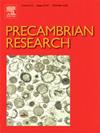Petrogenesis of late Paleoproterozoic I- and A-type granitoids in the southwestern Tarim Craton, NW China: Implications for post-collisional magmatism and tectonic evolution
IF 3.2
2区 地球科学
Q2 GEOSCIENCES, MULTIDISCIPLINARY
引用次数: 0
Abstract
Granitoids are important components of collisional orogens and record the tectonic evolution of orogenic belts. To better understand the late Paleoproterozoic orogeny in the Tiekelike area, southwestern Tarim Craton, China, we conducted a petrological, geochemical, and zircon U-Pb geochronological and Lu-Hf isotopic study of granitic dyke, quartz monzonite, quartz monzonitic dyke and granitic gneiss. The results show that these granitoids were emplaced between 1.88 and 1.85 Ga and can be divided into two groups. Group 1 (the granitic dyke and gneiss) are I-type granitoids with higher SiO2 and alkali contents, and Sr/Y ratios, but lower rare earth element contents than the group 2 (the quartz monzonite and quartz monzonitic dyke), which resemble A2-type granitoids. The I-type granitoids were generated by partial melting of ancient lower-crustal rocks, whereas the A2-type quartz monzonite and quartz monzonitic dyke were derived by melting of granodiorites under high-temperature and low-pressure conditions. All these late Paleoproterozoic I- and A-type granitoids formed in a post-collisional setting. Integrating our results with previous studies, we propose a model for the late Paleoproterozoic orogenic evolution of the Tarim Craton. The southeastern Tarim Craton (North Altyn Tagh area) first collided with other cratons/blocks at 2.00–1.95 Ga. Subsequently, the unified Tarim Craton was formed by the assembly of the southern and northern Tarim terranes at 1.92–1.90 Ga. Concurrently, the southwestern (Tiekelike area) and northeastern (Kuluketage area) Tarim Craton were also amalgamated with other cratons/blocks. The eastern Tarim Craton (Dunhuang area) then collided with other cratons/blocks at 1.82–1.80 Ga. Finally, the Tarim Craton experienced a high-temperature post-collisional orogeny. The orogeny that affected the Tarim Craton was an integral part of the tectonic evolution of the Columbia supercontinent during the Paleoproterozoic.
求助全文
约1分钟内获得全文
求助全文
来源期刊

Precambrian Research
地学-地球科学综合
CiteScore
7.20
自引率
28.90%
发文量
325
审稿时长
12 months
期刊介绍:
Precambrian Research publishes studies on all aspects of the early stages of the composition, structure and evolution of the Earth and its planetary neighbours. With a focus on process-oriented and comparative studies, it covers, but is not restricted to, subjects such as:
(1) Chemical, biological, biochemical and cosmochemical evolution; the origin of life; the evolution of the oceans and atmosphere; the early fossil record; palaeobiology;
(2) Geochronology and isotope and elemental geochemistry;
(3) Precambrian mineral deposits;
(4) Geophysical aspects of the early Earth and Precambrian terrains;
(5) Nature, formation and evolution of the Precambrian lithosphere and mantle including magmatic, depositional, metamorphic and tectonic processes.
In addition, the editors particularly welcome integrated process-oriented studies that involve a combination of the above fields and comparative studies that demonstrate the effect of Precambrian evolution on Phanerozoic earth system processes.
Regional and localised studies of Precambrian phenomena are considered appropriate only when the detail and quality allow illustration of a wider process, or when significant gaps in basic knowledge of a particular area can be filled.
 求助内容:
求助内容: 应助结果提醒方式:
应助结果提醒方式:


